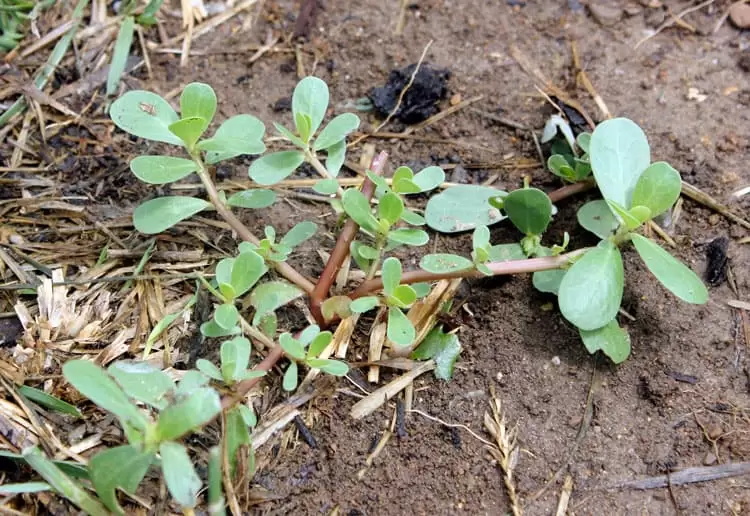If you’re anything like me, you love to garden not only for the amazing nutrient-dense food that a garden provides your family and community, but also for the beauty and wonder of the garden. Weeds are not only competition for the nutrients and water that food plants need, but they can also take away from the aesthetic that we’re trying to create.
I actually don’t dislike weeding – I find it very meditative – but I don’t enjoy creating more work for myself than necessary. So I’ve found a few ways to minimize weeds in the garden. Here are my top five strategies for a (relatively) weed free garden.
5 Strategies for a Weed Free Garden
1) Water the Plant, Not the Entire Bed
I have been a hand-waterer for most of my gardening life. I find that it enables me to keep close track of how plants are doing, and I can make adjustments to my watering schedule as necessary, or take time to pick off pests. As an added benefit, I’m only watering the area right around the plant. In fact, when I plant, I try to create a small well, and then water into this well. The area around the plants does not get wet, which helps keep weed seeds from germinating.
Of course this is not feasible for every gardener, but carefully placed drip irrigation can create the same results. Online Gardening School has an online course on how to build a PVC drip irrigation system for only $20!

Keeping bare soil covered might be the best defense against weeds. I have a lot of straw on hand, so I tend to mulch with straw. But you can also use wood chips, grass clippings, leaves, and lots of other organic materials. In addition to suppressing weeds, mulch also prevents moisture from evaporating from your soil, so it’s a wonderful addition to any garden plan.
3) Don’t Let your Weeds go to Seed!
Catch those weeds early and pull them out while they are small! They will be easier to pull when they are tiny, and if you’re diligent and never let your weeds go to seed, you’ll be saving yourself a lot of work later on!
4) Plant Thickly
Perhaps I am guilty of planting a bit TOO thickly, but I really believe that when you create nutrient-rich garden beds full of organic goodness, then you can afford to space plants much closer together than seed packages indicate. I like to push that one step further and sow lettuce or other greens into spaces between plants. As the season progresses, the lettuce will be eaten, and plants end up with the perfect spacing. With this strategy, the ground is never bare, so weeds don’t have a chance to to takeover.
5) Re-frame your Thinking Around “Weeds”
“What is a weed? A plant whose virtues have not yet been discovered.” ― Ralph Waldo Emerson.
I used to drive myself crazy trying to eradicate purslane and lamb’s quarters from my garden. Those weeds were persistent and grew everywhere. These days, my garden still has a ton of lamb’s quarters, not quite enough purslane for my tastes, and a fair amount of sorrel, and some dandelions. The difference? I now eat those weeds in salads and as cooked greens, so they are no longer pesky, but relished! (Purslane mixed with feta and tomato might be the best summer salad ever!) Many common weeds have medicinal or edible qualities that might turn them into a plant with virtue in your eyes.
Early this spring, I let my garden get away from me and ended up with more weeds than I could tolerate! Fortunately, because I’ve spent so many years building soil with lasagna gardening, the weeds were easy to pull. If your garden gets more weedy than you like, simply dedicate 5 minutes each day to pulling weeds and bit by bit you’ll make progress!
What are your favorite strategies for a weed-free garden? Share them in the comments below!
















I was wondering if some of you experienced gardeners could advise on the best way to start a first time garden in a un-worked area of the yard. I attempted a small garden a couple years ago and I didn’t have the soil manageable. Seems like I could never get it too the right depth in some areas. I remember when I was younger that my grandparents gardens were very loose deep soil with very little weeds. How do you get it too this point?? Should I just use a weed barrier and put dirt on top of that, or just keep tilling?
Jenn,
It takes time to build deep, tilthy soil. Regardless of whether you till some more or build a garden on top of a weed barrier (I’d recommend cardboard or newspaper over anything plastic), you’re probably going to want to bring in some soil amendments. Compost, or composted manure would be great. If you’re starting the garden from scratch on top of cardboard, check out this blog post: https://homestead-honey.com/2013/04/02/create-an-instant-garden-with-sheet-mulching/
I just discovered purslane was edible 2 years ago! It’s funny how something can go from frustrating to making you smile when you see it. 😉 I’ll be keeping an eye out for sorrel and lamb’s quarters now too. Thanks!
that’s exactly how I feel about those “weeds” now! good thing! Otherwise, they’d be driving me crazy! now if I can just find a redeeming quality for bindweed…
I found these uses during a search.
“Believe it or not, even this garden villain has a few uses. You can use pieces of bindweed as ties in place of twine when tying and staking plants. The flowers (which are actually very pretty) attract beneficial insects, and exude a soft fragrance. The leaves and stems can be used to make an all-natural dye, and there are also accounts of the roots being brewed as a tea to relieve constipation.”
I stand corrected! I probably won’t ever use bindweed as a tie, but I do appreciate their flowers. I love that they grow in our pasture, but in the garden, it’s another story. I’ve had experiences with gardens overrun with bindweed, and there is no easy solution. But I will definitely try the natural dye!
I would love to do some of your suggestions on cutting down on weeds……but…..every time I think of using straw or grass…..I shudder at the thought of all the seeds that come with using those items. In the process now of digging out and pulling weeds out of every inch of my garden and it is a rather LARGE garden and have to do it a few times during the growing season. Of course living in the country is wonderful but the winds bring in so many seeds that I cant keep up with them so I am afraid if I was to purchase straw and use untreated grass clippings that I would be buried in more weeds in future years. What are your thoughts? about ready to hit the Round up I am so frustrated.
Hi Kim, I’m so sorry that you’re having to deal with frustrating weeds! Here are a few thoughts: 1) If you’re buying good straw (not hay), there should not be too many seeds, as they get cut off. I used wheat straw this year and last, and sure I had a few sprouts, but they were no big deal to pull out. 2) How thickly are you spreading your mulch? I use several inches of straw if I want to suppress weeds. 3) You could also try wood chips or leaves, really thickly spread, particularly in paths. 4) As soon as you’re done with this weed, cover the garden right away so new sprouts don’t take hold.
I hope these work out for you. Anything that you can do to prevent using chemicals such as Round up will result in a healthier environment and healthier food. Good luck, and let me know how it goes later in the season!
Oh my, we are just in the process of digging out a bed because it,s been over run (and I mean inch thick carpets) full of sorrel! Thank you for telling me they are edible! I will make sure to keep what we pull up. If it wasn’t for the fact that it swallowed all our greens, I probably would have let them be. But they destroyed our crops. Too much of a good thing I guess. 🙂 Great post!
I hope you enjoy the sorrel. Some sources recommend eating it in moderation because of the oxalic acid that it contains. I think you’d have to eat quite a bit to become affected, but the flavor is so intense that you’d likely only eat a little at a time anyways!
We grabbed a pinch and tried it straight out of the flower beds today. So good! But yeah, I don’t think I could eat a bowl full. 🙂
I moved my blog and lost the link to yours and am so happy to have refound it!!
I just love this post. I do all the things you do. I don’t know if I could add another one that would be as effective. The only caveat that I have learned with using straw in the Northwest is that slugs love to hide under the straw and peep out at night to munch happily on… well? Everything.
I still use straw, of course, just create a well around each plant and get super liberal with the Sluggo. And crushed egg shells. And coffee grounds. And copper wire. And a revolver. (Just kidding. I’m a terrible shot.)
Hi Lindsey! So good to hear from you!!
Yes, it’s true that straw (really any mulch) is a good hiding spot for slugs. THey aren’t a big problem out here like they were in Oregon. We used to hand-pick slugs by the dozens and feed them to our ducks, who loved them. But cutting them in half works well too. It is a kind of nasty job, but very effective!
Love these tips! This year we’re trying mulching for the first time, and also planting really close together. And I’m just starting to learn about the different edible weeds.
Our neighbor is super passionate about edible weeds/ foraging, so he has taught us so much! A garden or forest walk is so different when you’re thinking about dinner!
It’s funny, because I use to buy purslane in the supermarket here in China.
The first time I saw purslane as something we can eat, was in a package of a greek salad seeds.
I bought it buy the pound last summer! It was such a great summer green.
What is the name of the weed (meal) in your last picture?
It’s an oxalis plant, or sorrel. It’s very lemony tasting and tart. The pods are particularly tasty!